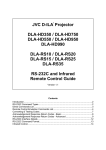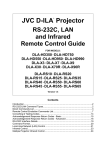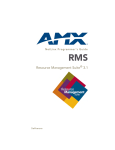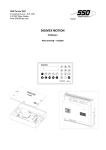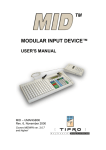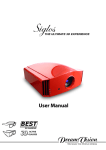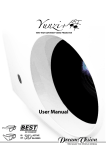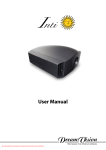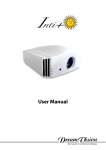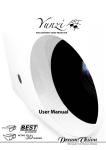Download JVC RS-232C User's Manual
Transcript
® JVC D-ILA Projector RS-232C, LAN and Infrared Remote Control Guide FOR MODELS: DLA-HD350 ● DLA-HD750 DLA-HD550 ● DLA-HD950 ● DLA-HD990 DLA-X3 ● DLA-X7 ● DLA-X9 DLA-RS10 ● DLA-RS20 DLA-RS15 ● DLA-RS25 ● DLA-RS35 DLA-RS40 ● DLA-RS50 ● DLA-RS60 Version 1.3 Contents Introduction..................................................................................................................2 RS-232C Command Types..........................................................................................2 Direct Commands List .................................................................................................3 Remote Control Emulation Commands List.................................................................4 Converting & Testing Codes......................................................................................10 Acknowledgement Response Return Codes - Basic .................................................11 Acknowledgement Response Return Codes - Advanced ..........................................12 RS-232C Interface Details .........................................................................................15 Command Format......................................................................................................16 Local Area Network (LAN) Control ............................................................................17 Infrared Control..........................................................................................................19 Multiple Projector Infrared Control .............................................................................20 JVC D-ILA Projector Remote Control Guide Introduction This guide provides all of the information required to enable Remote Control of JVC D-ILA projectors, either by RS-232C connection, Infrared Remote Control, or LAN. This will enable Custom Installers or users to remotely control almost every function on these projectors. The RS-232C control codes shown in this guide will control the JVC DLA-HD350, DLAHD750, DLA-HD550, DLA-HD950, DLA-HD990, DLA-X3, DLA-X7, DLA-X9, DLA-RS10, DLA-RS20, DLA-RS15, DLA-RS25, DLA-RS35, DLA-RS40, DLA-RS50 and DLA-RS60 DILA projectors via an RS-232C connection. The commands in this guide are in raw hexadecimal format and may require conversion to work with proprietary control systems. See page 10 for some examples of how to convert them. Please note that some commands work only with specific projector models and this is indicated where applicable. If required, full details of the RS-232C interface and command format are shown on pages 15-16. The Infrared Remote Control Codes shown in this guide will control the JVC DLA-HD350, DLA-HD750, DLA-HD550, DLA-HD950, DLA-HD990, DLA-X3, DLA-X7, DLA-X9, DLA-RS10, DLA-RS20, DLA-RS15, DLA-RS25, DLA-RS35, DLA-RS40, DLA-RS50 and DLA-RS60 DILA projectors via Infrared emulation. Some controllers will also generate Infrared commands from the RS-232C control codes. The LAN Remote Control Protocol and Codes shown in this guide will control the DLA-X7, DLA-X9, DLA-RS50 and DLA-RS60 over a LAN via a TCP/IP Network Connection. RS-232C Command Types There are two basic types of RS-232C commands. These are: 1. Direct Commands (see page 3) 2. Remote Control Emulation Commands (see pages 4-9). Direct Commands, as their name suggests, directly control the projector. Remote Control Emulation Commands achieve the same result, but they do it by emulating the functionality of the Remote Control Commands. The general rule is to use a Direct Command if one is available, otherwise use a Remote Control Emulation Command. One other difference between them is that Direct Commands will generally display fewer on-screen confirmation messages when the projector responds to them. Some commands are duplicated as both a Direct Command and a Remote Control Emulation Command. For these, the Direct Command should be used in preference to the Remote Control Emulation Command unless any additional on-screen confirmation messages provided by the Remote Control Emulation Command are required. Most of the commands in the Remote Control Emulation list do not actually appear on the Remote Control Handset, but they are all available if you wish to control those functions on the projector, either by RS-232C connection, or by Infrared Remote Control. In addition to the commands sent from the PC or controller to the projector, there are two types of Acknowledgement Response Return Codes returned by the projector to the PC or controller. When used with appropriate control equipment, these can be used to further customise the installation. Details of the Acknowledgement Response Return Codes and how to use them are on pages 11-14. The following seven pages contain a list of all useful Direct and Remote Control Emulation Commands. Where a command is specific to an individual model or a range of models, the applicable model(s) are shown in brackets after the command name. If no model is shown, then that command works with all models. Page 2 of 20 JVC D-ILA Projector Remote Control Guide Direct Commands: POWER Command Power Off Power On Hex Code 21 89 01 50 57 30 0A 21 89 01 50 57 31 0A INPUT SWITCHING Command Input – HDMI 1 Input – HDMI 2 Input – Component Input – S-Video Input – Video Input – PC (HD750/950/990/X7/X9/RS20/25/35/50/60) Input + (Go to next highest input) Input – (Go to next lowest input) 21 89 01 49 50 2B 0A 21 89 01 49 50 2D 0A TEST PATTERNS Command Test Pattern – Off Test Pattern – Colour Bars Test Pattern – Stair step (black and white) Test Pattern – Stair step (red) Test Pattern – Stair step (green) Test Pattern – Stair step (blue) Test Pattern – Crosshatch (green) Hex Code 21 89 01 54 53 30 0A 21 89 01 54 53 31 0A 21 89 01 54 53 36 0A 21 89 01 54 53 37 0A 21 89 01 54 53 38 0A 21 89 01 54 53 39 0A 21 89 01 54 53 41 0A GAMMA TABLE Command Gamma – Normal Gamma – A Gamma – B Gamma – C Gamma – D (HD550/950/990/X3/X7/X9/ RS15/25/35/40/50/60) Gamma – Custom1 Gamma – Custom2 Gamma – Custom3 Hex Code 21 89 01 49 50 36 0A 21 89 01 49 50 37 0A 21 89 01 49 50 32 0A 21 89 01 49 50 30 0A 21 89 01 49 50 31 0A 21 89 01 49 50 33 0A Hex Code 21 89 01 47 54 30 0A 21 89 01 47 54 31 0A 21 89 01 47 54 32 0A 21 89 01 47 54 33 0A 21 89 01 47 54 37 0A 21 89 01 47 54 34 0A 21 89 01 47 54 35 0A 21 89 01 47 54 36 0A GAMMA VALUE Command Gamma Correction Value – 1.8 Gamma Correction Value – 1.9 Gamma Correction Value – 2.0 Gamma Correction Value – 2.1 Gamma Correction Value – 2.2 (Default) Gamma Correction Value – 2.3 Gamma Correction Value – 2.4 Gamma Correction Value – 2.5 Gamma Correction Value – 2.6 Hex Code 21 89 01 47 50 30 0A 21 89 01 47 50 31 0A 21 89 01 47 50 32 0A 21 89 01 47 50 33 0A 21 89 01 47 50 34 0A 21 89 01 47 50 35 0A 21 89 01 47 50 36 0A 21 89 01 47 50 37 0A 21 89 01 47 50 38 0A TEST COMMAND Command Null Command (to check communication) Hex Code 21 89 01 00 00 0A Page 3 of 20 JVC D-ILA Projector Remote Control Guide Remote Control Emulation Commands Command Advanced – Direct access to Picture Adjust > Advanced menu (HD550/950/990/X3/X7/X9/ RS15/25/35/40/50/60) Anamorphic – Off (X3/X7/X9/RS40/50/60) (HD350/750/950/990/RS10/20/25/35 – Vertical Stretch – Off) Anamorphic – A (X3/X7/X9/RS40/50/60) (HD350/750/950/990/ RS10/20/25/35 – Vertical Stretch – On) Anamorphic – B (X3/X7/X9/RS40/50/60) Anamorphic – Cycles through Off/A/B (X3/X7/X9/RS40/50/60) Aspect – 16:9 Aspect – 4:3 Aspect – Zoom Aspect (PC) – Auto (X7/X9/RS50/60) Aspect (PC) – Full (X7/X9/RS50/60) Aspect (PC) – Just (X7/X9/RS50/60) Aspect + (cycles through all available modes) Auto Align (PC input on HD750/950/990/X7/ X9/RS20/25/35/50/60) Back – Steps backwards through menus and removes any OSD messages BNR (Block Noise Reduction) – Off BNR (Block Noise Reduction) – On Bright Level – (X7/X9/RS50/60) Bright Level + (X7/X9/RS50/60) Brightness – Brightness + Brightness Adj. (Adjustment Bar On/Off toggle) CEC – Off CEC – On Clear Motion Drive – Off (X3/X7/X9/RS40/50/60) Clear Motion Drive – Mode 1 (X3/X7/X9/RS40/50/60) Clear Motion Drive – Mode 2 (X3/X7/X9/RS40/50/60) Clear Motion Drive – Mode 3 (X3/X7/X9/RS40/50/60) Clear Motion Drive – Mode 4 (X3/X7/X9/RS40/50/60) Clear Motion Drive – Inverse Telecine (X3/X7/X9/RS40/50/60) Clear Motion Drive – Cycles through: Off/ Mode 1/Mode 2/Mode 3/Mode 4/Inverse Telecine (X3/X7/X9/RS40/50/60) Colour – Colour + Colour Adj. (Adjustment Bar On/Off toggle) Hex Code ASCII 21 89 01 52 43 37 33 37 33 0A 73 21 89 01 52 43 37 33 32 34 0A 24 21 89 01 52 43 37 33 32 33 0A 23 21 89 01 52 43 37 33 32 42 0A 2B 21 89 01 52 43 37 33 43 35 0A C5 21 89 01 52 43 37 33 32 36 0A 21 89 01 52 43 37 33 32 35 0A 21 89 01 52 43 37 33 32 37 0A 21 89 01 52 43 37 33 41 45 0A 21 89 01 52 43 37 33 42 30 0A 21 89 01 52 43 37 33 41 46 0A 21 89 01 52 43 37 33 37 37 0A 26 25 27 AE B0 AF 77 21 89 01 52 43 37 33 31 33 0A 13 21 89 01 52 43 37 33 30 33 0A 03 21 89 01 52 43 37 33 31 30 0A 21 89 01 52 43 37 33 30 46 0A 21 89 01 52 43 37 33 41 33 0A 21 89 01 52 43 37 33 41 32 0A 21 89 01 52 43 37 33 37 42 0A 21 89 01 52 43 37 33 37 41 0A 10 0F A3 A2 7B 7A 21 89 01 52 43 37 33 30 39 0A 09 21 89 01 52 43 37 33 35 37 0A 21 89 01 52 43 37 33 35 36 0A 57 56 21 89 01 52 43 37 33 34 37 0A 47 21 89 01 52 43 37 33 43 45 0A CE 21 89 01 52 43 37 33 43 46 0A CF 21 89 01 52 43 37 33 34 38 0A 48 21 89 01 52 43 37 33 34 39 0A 49 21 89 01 52 43 37 33 34 41 0A 4A 21 89 01 52 43 37 33 38 41 0A 8A 21 89 01 52 43 37 33 37 44 0A 21 89 01 52 43 37 33 37 43 0A 21 89 01 52 43 37 33 31 35 0A 7D 7C 15 Page 4 of 20 JVC D-ILA Projector Remote Control Guide Command Colour Management – Off (HD750/950/ 990/X7/X9/RS20/RS/35/50/60) Colour Management – Custom1 (HD750/950/990/X7/X9/RS20/25/35/50/60) Colour Management – Custom2 (HD750/950/990/X7/X9/RS20/25/35/50/60) Colour Management – Custom3 (HD750/950/990/X7/X9/RS20/25/35/50/60) Colour Management – Cycles through: Off/ Custom1/Custom2/Custom3 (X7/X9/RS50/60) Colour Profile – Cycles through all Colour Profiles that are available in the current Picture Mode (X7/X9/RS50/60) Colour Space – Cycles through Standard/ Wide1/Wide2 (X3/RS40) Colour Temp. – 5800K (HD350/550/750/950/990/RS10/15/20/25/35) Colour Temp. – 6500K Colour Temp. – 7500K (HD350/550/750/950/990/RS10/15/20/25/35) Colour Temp. – 9300K (HD350/550/750/950/990/RS10/15/20/25/35) Colour Temp. – Custom1 Colour Temp. – Custom2 Colour Temp. – Custom3 Colour Temp. – High Bright (HD350/550/750/ 950/990/X3/RS10/15/20/25/35/40) Colour Temp. + (cycles through all options) Colour Temperature Gain Blue – (X3/X7/X9/RS40/50/60) Colour Temperature Gain Blue + (X3/X7/X9/RS40/50/60) Colour Temperature Gain Green – (X3/X7/X9/RS40/50/60) Colour Temperature Gain Green + (X3/X7/X9/RS40/50/60) Colour Temperature Gain Red – (X3/X7/X9/RS40/50/60) Colour Temperature Gain Red + (X3/X7/X9/RS40/50/60) Colour Temperature Offset Blue – (X3/X7/X9/RS40/50/60) Colour Temperature Offset Blue + (X3/X7/X9/RS40/50/60) Colour Temperature Offset Green – (X3/X7/X9/RS40/50/60) Colour Temperature Offset Green + (X3/X7/X9/RS40/50/60) Colour Temperature Offset Red – (X3/X7/X9/RS40/50/60) Colour Temperature Offset Red + (X3/X7/X9/RS40/50/60) Contrast – Hex Code ASCII 21 89 01 52 43 37 33 36 30 0A 60 21 89 01 52 43 37 33 36 31 0A 61 21 89 01 52 43 37 33 36 32 0A 62 21 89 01 52 43 37 33 36 33 0A 63 21 89 01 52 43 37 33 38 39 0A 89 21 89 01 52 43 37 33 38 38 0A 88 21 89 01 52 43 37 33 43 44 0A CD 21 89 01 52 43 37 33 34 45 0A 4E 21 89 01 52 43 37 33 34 46 0A 4F 21 89 01 52 43 37 33 35 30 0A 50 21 89 01 52 43 37 33 35 31 0A 51 21 89 01 52 43 37 33 35 33 0A 21 89 01 52 43 37 33 35 34 0A 21 89 01 52 43 37 33 35 35 0A 53 54 55 21 89 01 52 43 37 33 35 32 0A 52 21 89 01 52 43 37 33 37 36 0A 76 21 89 01 52 43 37 33 39 31 0A 91 21 89 01 52 43 37 33 39 30 0A 90 21 89 01 52 43 37 33 38 46 0A 8F 21 89 01 52 43 37 33 38 45 0A 8E 21 89 01 52 43 37 33 38 44 0A 8D 21 89 01 52 43 37 33 38 43 0A 8C 21 89 01 52 43 37 33 39 37 0A 97 21 89 01 52 43 37 33 39 36 0A 96 21 89 01 52 43 37 33 39 35 0A 95 21 89 01 52 43 37 33 39 34 0A 94 21 89 01 52 43 37 33 39 33 0A 93 21 89 01 52 43 37 33 39 32 0A 92 21 89 01 52 43 37 33 37 39 0A 79 Page 5 of 20 JVC D-ILA Projector Remote Control Guide Command Contrast + Contrast Adj. (Adjustment Bar On/Off toggle) CTI (Colour Transient Improvement) – Off CTI (Colour Transient Improvement) – Low CTI (Colour Transient Improvement) – Middle CTI (Colour Transient improvement) – High Cursor Up ▲ Cursor Down ▼ Cursor Left ◄ Cursor Right ► Dark Level – (X7/X9/RS50/60) Dark Level + (X7/X9/RS50/60) Detail Enhance – Detail Enhance + Film Tone Blue – (X7/X9/RS50/60) Film Tone Blue + (X7/X9/RS50/60) Film Tone Green – (X7/X9/RS50/60) Film Tone Green + (X7/X9/RS50/60) Film Tone Red – (X7/X9/RS50/60) Film Tone Red + (X7/X9/RS50/60) Film Tone White – (X7/X9/RS50/60) Film Tone White + (X7/X9/RS50/60) Gamma – Normal Gamma – A Gamma – B Gamma – C Gamma – D (HD550/950/990/X3/X7/X9/ RS15/25/35/40/50/60) Gamma – Custom1 Gamma – Custom2 Gamma – Custom3 Gamma + (cycles through all options) Hide (On/Off toggle) Hide – Off (X3/X7/X9/RS40/50/60) Hide – On (X3/X7/X9/RS40/50/60) Horizontal Position – (X3/X7/X9/RS40/50/60) Horizontal Position + (X3/X7/X9/RS40/50/60) Information (displays Information tab of menu) Input – HDMI-1 Input – HDMI-2 Input – Component Input – PC (HD750/950/990/X7/X9/ RS20/25/35/50/60) Input – S-Video (HD350/550/750/950/990) Input – Video (HD350/550/750/950/990) Input + (cycles through all inputs) ISF – Day (X7/X9/RS50/60) ISF – Night (X7/X9/RS50/60) ISF – Off (HD950/990/X7/X9/RS25/35/50/60) ISF – On (HD950/990/X7/X9/RS25/35/50/60) Keystone Correction Horizontal – Keystone Correction Horizontal + Hex Code 21 89 01 52 43 37 33 37 38 0A 21 89 01 52 43 37 33 30 41 0A 21 89 01 52 43 37 33 35 43 0A 21 89 01 52 43 37 33 35 44 0A 21 89 01 52 43 37 33 35 45 0A 21 89 01 52 43 37 33 35 46 0A 21 89 01 52 43 37 33 30 31 0A 21 89 01 52 43 37 33 30 32 0A 21 89 01 52 43 37 33 33 36 0A 21 89 01 52 43 37 33 33 34 0A 21 89 01 52 43 37 33 41 35 0A 21 89 01 52 43 37 33 41 34 0A 21 89 01 52 43 37 33 31 32 0A 21 89 01 52 43 37 33 31 31 0A 21 89 01 52 43 37 33 41 31 0A 21 89 01 52 43 37 33 41 30 0A 21 89 01 52 43 37 33 39 46 0A 21 89 01 52 43 37 33 39 45 0A 21 89 01 52 43 37 33 39 44 0A 21 89 01 52 43 37 33 39 43 0A 21 89 01 52 43 37 33 39 42 0A 21 89 01 52 43 37 33 39 41 0A 21 89 01 52 43 37 33 33 38 0A 21 89 01 52 43 37 33 33 39 0A 21 89 01 52 43 37 33 33 41 0A 21 89 01 52 43 37 33 33 42 0A ASCII 78 0A 5C 5D 5E 5F 01 02 36 34 A5 A4 12 11 A1 A0 9F 9E 9D 9C 9B 9A 38 39 3A 3B 21 89 01 52 43 37 33 33 46 0A 3F 21 89 01 52 43 37 33 33 43 0A 21 89 01 52 43 37 33 33 44 0A 21 89 01 52 43 37 33 33 45 0A 21 89 01 52 43 37 33 37 35 0A 21 89 01 52 43 37 33 31 44 0A 21 89 01 52 43 37 33 44 31 0A 21 89 01 52 43 37 33 44 30 0A 21 89 01 52 43 37 33 41 42 0A 21 89 01 52 43 37 33 41 41 0A 21 89 01 52 43 37 33 37 34 0A 21 89 01 52 43 37 33 37 30 0A 21 89 01 52 43 37 33 37 31 0A 21 89 01 52 43 37 33 34 44 0A 3C 3D 3E 75 1D D1 D0 AB AA 74 70 71 4D 21 89 01 52 43 37 33 34 36 0A 46 21 89 01 52 43 37 33 34 43 0A 21 89 01 52 43 37 33 34 42 0A 21 89 01 52 43 37 33 30 38 0A 21 89 01 52 43 37 33 36 34 0A 21 89 01 52 43 37 33 36 35 0A 21 89 01 52 43 37 33 35 41 0A 21 89 01 52 43 37 33 35 42 0A 21 89 01 52 43 37 33 34 31 0A 21 89 01 52 43 37 33 34 30 0A 4C 4B 08 64 65 5A 5B 41 40 Page 6 of 20 JVC D-ILA Projector Remote Control Guide Command Keystone Correction Vertical – Keystone Correction Vertical + Lens Aperture – 1 (HD350/HD550) Lens Aperture – 2 (HD350/HD550) Lens Aperture – 3 (HD350/HD550) Lens Aperture – If Lens Aperture Gauge is not displayed – displays gauge. If Lens Aperture Gauge is already displayed – Lens Aperture is decreased (X3/X7/X9/RS40/50/60) Lens Aperture + If Lens Aperture Gauge is not displayed – displays gauge. If Lens Aperture Gauge is already displayed – Lens Aperture is increased (X3/X7/X9/RS40/50/60) Lens Aperture Adj. (HD350/750/950/990/ RS10/20/25/35 – Adjustment Bar On/Off toggle) (X3/ X7/X9/RS40/50/60 – Displays Adjustment Bar) (HD550/RS15 – Cycles through all options) Lens Control (cycles through all options) Lens Focus – Lens Focus + Lens Shift – Down Lens Shift – Left Lens Shift – Right Lens Shift – Up Lens Zoom – In Lens Zoom – Out Mask Top – (X3/X7/X9/RS40/50/60) Mask Top + (X3/X7/X9/RS40/50/60) Mask Bottom – (X3/X7/X9/RS40/50/60) Mask Bottom + (X3/X7/X9/RS40/50/60) Mask Left – (X3/X7/X9/RS40/50/60) Mask Left + (X3/X7/X9/RS40/50/60) Mask Right – (X3/X7/X9/RS40/50/60) Mask Right + (X3/X7/X9/RS40/50/60) Menu (On/Off toggle) Menu Position (HD550/950/990/X3/X7/X9/ RS15/25/35/40/50/60) MNR (Mosquito Noise Reduction) – MNR (Mosquito Noise Reduction) + NR (toggles display of RNR/MNR) OK (to accept currently selected option) Phase (PC Input) – (X7/X9/RS50/60) Phase (PC Input) + (X7/X9/RS50/60) Picture Adjust (HD550/750/990/X3/X7/X9/ RS15/25/35/40/50/60) Picture Mode – 3D (X3/X7/X9/RS40/50/60) Picture Mode – Cinema1 (X3/X7/X9/RS40/50/60 – Film Mode) Picture Mode – Cinema2 (X3/X7/X9/RS40/50/60 – Cinema Mode) Hex Code 21 89 01 52 43 37 33 31 43 0A 21 89 01 52 43 37 33 31 42 0A 21 89 01 52 43 37 33 32 38 0A 21 89 01 52 43 37 33 32 39 0A 21 89 01 52 43 37 33 32 41 0A ASCII 1C 1B 28 29 2A 21 89 01 52 43 37 33 31 46 0A 1F 21 89 01 52 43 37 33 31 45 0A 1E 21 89 01 52 43 37 33 32 30 0A 20 21 89 01 52 43 37 33 33 30 0A 21 89 01 52 43 37 33 33 32 0A 21 89 01 52 43 37 33 33 31 0A 21 89 01 52 43 37 33 32 32 0A 21 89 01 52 43 37 33 34 34 0A 21 89 01 52 43 37 33 34 33 0A 21 89 01 52 43 37 33 32 31 0A 21 89 01 52 43 37 33 33 35 0A 21 89 01 52 43 37 33 33 37 0A 21 89 01 52 43 37 33 42 36 0A 21 89 01 52 43 37 33 42 35 0A 21 89 01 52 43 37 33 42 38 0A 21 89 01 52 43 37 33 42 37 0A 21 89 01 52 43 37 33 42 32 0A 21 89 01 52 43 37 33 42 31 0A 21 89 01 52 43 37 33 42 34 0A 21 89 01 52 43 37 33 42 33 0A 21 89 01 52 43 37 33 32 45 0A 30 32 31 22 44 43 21 35 37 B6 B5 B8 B7 B2 B1 B4 B3 2E 21 89 01 52 43 37 33 34 32 0A 42 21 89 01 52 43 37 33 30 45 0A 21 89 01 52 43 37 33 30 44 0A 21 89 01 52 43 37 33 31 38 0A 21 89 01 52 43 37 33 32 46 0A 21 89 01 52 43 37 33 41 39 0A 21 89 01 52 43 37 33 41 38 0A 0E 0D 18 2F A9 A8 21 89 01 52 43 37 33 37 32 0A 72 21 89 01 52 43 37 33 38 37 0A 87 21 89 01 52 43 37 33 36 39 0A 69 21 89 01 52 43 37 33 36 38 0A 68 Page 7 of 20 JVC D-ILA Projector Remote Control Guide Command Picture Mode – Cinema3 (HD550/750/990/ RS15/25/35) (X3/X7/X9/RS40/50/60 – Animation Mode) Picture Mode – Dynamic (HD350/550/750/950/990) Picture Mode – Natural Picture Mode – Stage Picture Mode – THX (HD750/950/990/X7/X9/RS20/25/35/50/60) Picture Mode – User1 Picture Mode – User2 Picture Mode – User3 (HD550/750/950/990/X3/RS20/25/35/40) Pixel Shift – Horizontal Blue – (X3/X7/X9/RS40/50/60) Pixel Shift – Horizontal Blue + (X3/X7/X9/RS40/50/60) Pixel Shift – Horizontal Green – (X3/X7/X9/RS40/50/60) Pixel Shift – Horizontal Green + (X3/X7/X9/RS40/50/60) Pixel Shift – Horizontal Red – (X3/X7/X9/RS40/50/60) Pixel Shift – Horizontal Red + (X3/X7/X9/RS40/50/60) Pixel Shift – Vertical Blue – (X3/X7/X9/RS40/50/60) Pixel Shift – Vertical Blue + (X3/X7/X9/RS40/50/60) Pixel Shift – Vertical Green – (X3/X7/X9/RS40/50/60) Pixel Shift – Vertical Green + (X3/X7/X9/RS40/50/60) Pixel Shift – Vertical Red – (X3/X7/X9/RS40/50/60) Pixel Shift – Vertical Red + (X3/X7/X9/RS40/50/60) Power – Off (send twice with short delay between to switch off) Power – On RNR (Random Noise Reduction) – RNR (Random Noise Reduction) + Screen Adjust – Off (X3/RS40) Screen Adjust – A (X3/RS40) Screen Adjust – B (X3/RS40) Screen Adjust – C (X3/RS40) Sharpness – Sharpness + Sharpness Adj. (Adjustment Bar On/Off toggle) Shutter – Off – Un-synchronises shutter with “Hide” function (HD550/950/990/X3/X7/X9/ RS15/25/35/40/50/60) Hex Code ASCII 21 89 01 52 43 37 33 36 36 0A 66 21 89 01 52 43 37 33 36 42 0A 6B 21 89 01 52 43 37 33 36 41 0A 21 89 01 52 43 37 33 36 37 0A 6A 67 21 89 01 52 43 37 33 36 46 0A 6F 21 89 01 52 43 37 33 36 43 0A 21 89 01 52 43 37 33 36 44 0A 6C 6D 21 89 01 52 43 37 33 36 45 0A 6E 21 89 01 52 43 37 33 42 45 0A BE 21 89 01 52 43 37 33 42 44 0A BD 21 89 01 52 43 37 33 42 43 0A BC 21 89 01 52 43 37 33 42 42 0A BB 21 89 01 52 43 37 33 42 41 0A BA 21 89 01 52 43 37 33 42 39 0A B9 21 89 01 52 43 37 33 43 34 0A C4 21 89 01 52 43 37 33 43 33 0A C3 21 89 01 52 43 37 33 43 32 0A C2 21 89 01 52 43 37 33 43 31 0A C1 21 89 01 52 43 37 33 43 30 0A C0 21 89 01 52 43 37 33 42 46 0A BF 21 89 01 52 43 37 33 30 36 0A 06 21 89 01 52 43 37 33 30 35 0A 21 89 01 52 43 37 33 30 43 0A 21 89 01 52 43 37 33 30 42 0A 21 89 01 52 43 37 33 38 30 0A 21 89 01 52 43 37 33 38 31 0A 21 89 01 52 43 37 33 38 32 0A 21 89 01 52 43 37 33 38 33 0A 21 89 01 52 43 37 33 37 46 0A 21 89 01 52 43 37 33 37 45 0A 05 0C 0B 80 81 82 83 7F 7E 21 89 01 52 43 37 33 31 34 0A 14 21 89 01 52 43 37 33 32 44 0A 2D Page 8 of 20 JVC D-ILA Projector Remote Control Guide Command Shutter – On – Synchronises shutter with “Hide” function (HD550/950/990/X3/X7/X9/ RS15/25/35/40/50/60) Shutter – Open (HD550/950/990/X3/X7/X9/ RS15/25/35/40/50/60) Shutter – Close (HD550/950/990/X3/X7/X9/ RS15/25/35/40/50/60) Test Pattern (cycles through all patterns) THX – Off (X7/X9/RS50/60) THX – On (X7/X9/RS50/60) THX – Bright (X7/X9/RS50/60) THX – Dark (X7/X9/RS50/60) Tint – (X3/X7/X9/RS40/50/60) Tint + (X3/X7/X9/RS40/50/60) Tint Adj. (Adjustment Bar On/Off toggle) Tracking (PC Input) – (X7/X9/RS50/60) Tracking (PC Input) + (X7/X9/RS50/60) Vertical Position – (X3/X7/X9/RS40/50/60) Vertical Position + (X3/X7/X9/RS40/50/60) Vertical Stretch – Off (HD350/550/750/950/990/RS10/15/20/25/35) (X3/X7/X9/RS40/50/60 – Anamorphic Off) Vertical Stretch – On (HD350/550/750/950/990/RS10/15/20/25/35) (X3/X7/X9/RS40/50/60 – Anamorphic A) Hex Code ASCII 21 89 01 52 43 37 33 32 43 0A 2C 21 89 01 52 43 37 33 31 41 0A 1A 21 89 01 52 43 37 33 31 39 0A 19 21 89 01 52 43 37 33 35 39 0A 21 89 01 52 43 37 33 43 37 0A 21 89 01 52 43 37 33 43 38 0A 21 89 01 52 43 37 33 38 35 0A 21 89 01 52 43 37 33 38 36 0A 21 89 01 52 43 37 33 39 39 0A 21 89 01 52 43 37 33 39 38 0A 21 89 01 52 43 37 33 31 36 0A 21 89 01 52 43 37 33 41 37 0A 21 89 01 52 43 37 33 41 36 0A 21 89 01 52 43 37 33 41 44 0A 21 89 01 52 43 37 33 41 43 0A 59 C7 C8 85 86 99 98 16 A7 A6 AD AC 21 89 01 52 43 37 33 32 34 0A 24 21 89 01 52 43 37 33 32 33 0A 23 Page 9 of 20 JVC D-ILA Projector Remote Control Guide Converting & Testing Codes The codes shown on pages 3-9 are raw hex codes and must be converted to the appropriate format in order to work with proprietary controllers such as those from Crestron or AMX. To help with the conversion, here are two sample strings for those brands: The Power On Command (from page 3) is: 21 89 01 50 57 31 0A Crestron controller – Power On Command: \x21\x89\x01\x50\x57\x31\x0A\r AMX controller – Power On Command: SEND_STRING dvProj, "$21, $89, $01, $50, $57, $31, $0A” You can see from these examples that it is easy to convert any of the RS-232C codes in this guide into the equivalent Crestron or AMX control strings. This should also be the case for most other controllers that allow transmission of hex data. In order to test these commands, it is useful to have a program that can send raw hex codes directly to the Serial Port on a PC. There are many programs that can do this, but here are a few that are useful for test purposes: RS232 Hex Com Tool – 30-Day Evaluation Version available from http://www.rs232pro.com This is a very simple to use program that lets you send any hex command and see the response from the projector. The Evaluation Version times out every five minutes, but it can be instantly restarted and is very simple to use. Hercules Setup Utility – Free from: http://www.hw-group.com/products/hercules/index_en.html This is a slightly more complex program that can do far more than just send hex commands. Use the “Serial” tab to send commands direct to the serial port. This program is recommended if you are a more experienced PC user. It is also useful for testing the LAN Control functions on the DLA-X7, DLA-X9, DLA-RS50 and DLA-RS60. Docklight – Evaluation version available from: http://www.docklight.de Another more advanced program. This one is particularly good for checking the Acknowledgement Response Return Codes. AccessPort – Free from: http://www.sudt.com/en/ap/index.html This is an intermediate level program. Not as easy to use as some of the others, but free. Eltima Software Advanced Serial Port Terminal – 14-Day Evaluation Version available from: http://www.eltima.com/products/serial-port-terminal/ This is an excellent intermediate level program. It allows the commands to be sent in loops for repeated testing. It also shows the return codes in both hex and ASCII formats. If you want to use just one program from those above for general RS-232C and/or LAN testing, I would recommend the Hercules Setup Utility. All of these programs will accept the hex codes exactly as shown in this guide. They can simply be copied and pasted into the programs and then sent to the projector. Most of the programs require the user to switch to hex mode before sending hex codes. Please note that you will require a cross-connected serial cable (sometimes called a nullmodem or DTE/DTE cable) if you wish to connect the projector to a PC for testing. Page 10 of 20 JVC D-ILA Projector Remote Control Guide Acknowledgement Response Return Codes - Basic In most installations, it will normally be sufficient just to send a command to the projector and assume that the projector will carry it out requested. In some installations, there may be a requirement to confirm that the projector has carried out the command before continuing. This is particularly important when sending multiple commands. It is possible to check if the projector has carried out a command by monitoring the Acknowledgement Response Return Code returned by the projector. The projector will return an Acknowledgement Response Return Code for any valid command that it receives. The general format of the Acknowledgement Response returned from the projector is: 06 89 01 CC CC 0A - Where CC CC is the first 2 bytes of the command that was originally sent to the projector (not including the 21 89 01). Taking the Power On command from page 3 as an example, to switch the projector power on, send to the projector: 21 89 01 50 57 31 0A If the Power On Command completes successfully, the projector will return: 06 89 01 50 57 0A This Acknowledgement Response format is the same for all of the commands listed above. The Acknowledgement Response Return Codes for all of the commands listed on pages 3-9 (assuming the command is successful) are as follows: Function Power On/Off Input Changed Test Pattern On/Off Gamma Table Changed Gamma Value Changed Remote Control Emulation Command (all commands) Test (Null Command – to check communication) Acknowledgement Response 06 89 01 50 57 0A 06 89 01 49 50 0A 06 89 01 54 53 0A 06 89 01 47 54 0A 06 89 01 47 50 0A 06 89 01 52 43 0A 06 89 01 00 00 0A The list above includes a Test (null) response. This doesn’t actually do anything, but it is useful to check that the controller is communicating with the projector before sending any real commands. This should be used with the Test Command shown on page 3. To use the test command, send to the projector: 21 89 01 00 00 0A Assuming the projector is connected to the PC or controller correctly, it will respond with: 06 89 01 00 00 0A It will respond whether it is in Standby or Powered On. Page 11 of 20 JVC D-ILA Projector Remote Control Guide Acknowledgement Response Return Codes - Advanced For some functions, it is possible to obtain a more detailed response from the projector. This is useful where different actions are required depending on the current projector settings or status. To request the detailed response, taking the above example of the Power Command, send to the projector: 3F 89 01 50 57 0A If the projector receives the enquiry command, as a confirmation that it has received the command, it will first respond with exactly the same information as that returned by the basic Acknowledgement Return Code shown on page 11: 06 89 01 50 57 0A Next, the projector will send the detailed response. It will send: 40 89 01 50 57 RR 0A – Where RR is the Detailed Response Return Code. For clarity, the two returned responses are separated here. In practice, they are returned from the projector as one continuous string. For the Power Status Enquiry, the possible values for the Detailed Response Return Code status (RR) are: 30 – Standby 31 – Power On 32 – Cooling 34 – Emergency So, as a full worked example, if we send to the projector: 3F 89 01 50 57 0A If the projector were currently cooling down after being switched to Standby, it would return: 06 89 01 50 57 0A 40 89 01 50 57 32 0A If the projector were on Standby, it would return: 06 89 01 50 57 0A 40 89 01 50 57 30 0A A list of all of the useful enquiry codes, together with all possible detailed responses is below: Power Status (to confirm the current Power Status) Enquiry Command (to projector) 3F 89 01 50 57 0A 06 89 01 50 57 0A 40 89 01 50 57 RR 0A Response (from projector) Response (RR) 30 31 32 34 Meaning Standby Power On Cooling Emergency Page 12 of 20 JVC D-ILA Projector Remote Control Guide Input Status (to confirm the current Video Input) Enquiry Command (to projector) 3F 89 01 49 50 0A 06 89 01 49 50 0A 40 89 01 49 50 RR 0A Response (from projector) Response (RR) 30 31 32 33 36 37 Meaning S-Video Video Component PC (HD750/950/990/X7/X9/RS20/25/35/50/60) HDMI 1 HDMI 2 Gamma Table (to confirm the current Gamma Table) Enquiry Command (to projector) 3F 89 01 47 54 0A 06 89 01 47 54 0A 40 89 01 47 54 RR 0A Response (from projector) Response (RR) 30 31 32 33 34 35 36 Meaning Gamma – Normal Gamma – A Gamma – B Gamma – C Gamma – Custom1 Gamma – Custom2 Gamma – Custom3 Gamma Value (to confirm the current Gamma Value) Enquiry Command (to projector) 3F 89 01 47 50 0A 06 89 01 47 50 0A 40 89 01 47 50 RR 0A Response (from projector) Response (RR) 30 31 32 33 34 35 36 37 38 Meaning Gamma Correction Value – 1.8 Gamma Correction Value – 1.9 Gamma Correction Value – 2.0 Gamma Correction Value – 2.1 Gamma Correction Value – 2.2 Gamma Correction Value – 2.3 Gamma Correction Value – 2.4 Gamma Correction Value – 2.5 Gamma Correction Value – 2.6 Source Status (to confirm the current Video Source Status) Enquiry Command (to projector) 3F 89 01 53 43 0A 06 89 01 53 43 0A 40 89 01 53 43 RR 0A Response (from projector) Response (RR) 00 30 31 Meaning JVC Logo displayed No signal or signal out of range Signal input correctly Page 13 of 20 JVC D-ILA Projector Remote Control Guide There is one enquiry command that has a different response from the projector to those listed above. This is the Model Status enquiry. When this enquiry sent to the projector, the projector will respond with a 14-byte string that identifies the model number(s) of the projector. Details are as follows: Model Status (to confirm the current Projector Model) Enquiry Command (to projector) 3F 89 01 4D 44 0A 06 89 01 4D 44 0A 40 89 01 4D 44 RR 0A Response (from projector) Response (RR) 49 4C 41 46 50 4A 20 2D 2D 20 2D 58 48 34 49 4C 41 46 50 4A 20 2D 2D 20 2D 58 48 37 49 4C 41 46 50 4A 20 2D 2D 20 2D 58 48 35 49 4C 41 46 50 4A 20 2D 2D 20 2D 58 48 38 49 4C 41 46 50 4A 20 2D 2D 20 2D 58 48 41 49 4C 41 46 50 4A 20 2D 2D 20 2D 58 48 39 49 4C 41 46 50 4A 20 2D 2D 20 2D 58 48 42 49 4C 41 46 50 4A 20 2D 2D 20 2D 58 48 43 Meaning DLA-HD350 DLA-RS10 DLA-HD750 & DLA-RS20 DLA-HD550 DLA-RS15 DLA-HD950/HD990/DLA-RS25/RS35 DLA-X3 & DLA-RS40 DLA-X7/X9 & DLA-RS50/60 Page 14 of 20 JVC D-ILA Projector Remote Control Guide RS-232C Interface Details The RS-232C interface on the projector is a standard 9 pin D-Sub male socket. The pin connections for the projector are as follows: Pin No. 2 3 5 1, 4 & 6-9 Signal Rx Data Tx Data Ground No Connection Function Receive Data Transmit Data Signal ground – Signal Direction Computer/Controller to Projector Projector to Computer/Controller – – Connector Looking at the connector from the side of the projector, the pins are as follows: Communication Parameters The communication parameters for the projector are as follows: Parameter Interface Mode Data Rate Character Length Parity Start Bit Stop Bit Flow Control Data Format Value RS-232C Asynchronous 19200bps (19.2kbps) 8 Bit None 1 1 None Binary Diagram of Data Format: D0 D1 D2 D3 D4 D5 D6 D7 Start Bit Stop Bit Set both send and receive modes to Hex in control software. Page 15 of 20 JVC D-ILA Projector Remote Control Guide Command Format The RS-232C commands are bidirectional and consist of a variable number of hexadecimal numbers. All of the commands sent to the projector shown in this guide are either 7 bytes or 10 bytes long. The Acknowledgement Response Return Codes returned from the projector can be between 6 and 14 bytes long. The basic format of the commands is as follows: Section Header Unit ID Command Data End Size 1 byte 2 bytes 2 bytes Variable 1 byte. Comments Can be one of four possible values – see below Fixed – always 89 01 See below Length varies depending on command – see below Fixed – always 0A Taking each of these sections in turn: Header The header can be one of 4 possible values. These are: 21 – Operating Command (from PC/controller to projector) 3F – Acknowledgement Response return Code Request (from PC/controller to projector) 06 – Acknowledgement Response Return Code – Basic (from projector to PC/controller) 40 – Acknowledgement Response Return Code – Detailed (from projector to PC/controller) Unit ID This is fixed at 89 01 for all models. Command This is the command sent to/from the projector and varies depending on the command. As an example, the Power Command is 50 57. The other commands can be worked out from the tables on pages 3-9. Data This is the value to apply to the command. Using the Power example above, the data value for Off is 30 and the data value for On is 31. End This signifies the end of the command and is fixed at 0A for all models. Putting all this together, a typical command (Power On) to the projector would therefore be: Header 21 Unit ID 89 Command 01 50 57 Data 31 End 0A Error Handling The projector will ignore any commands that it cannot recognise, e.g. Unit ID does not match, parity error, invalid command, etc. It will also ignore any inappropriate commands, e.g. Power On when in cooling mode. The projector will discard any commands received if there is a break of 50ms or longer in the incoming data. If consecutive commands are used, it is assumed that any external controller will not transmit a command until it has received an appropriate Acknowledgement Response Return Code to confirm that the projector is ready to accept the next command (see page 11 for details). Page 16 of 20 JVC D-ILA Projector Remote Control Guide Local Area Network (LAN) Control (DLA-X7, DLA-X9, DLA-RS50 and DLA-RS60) In addition to RS-232C and Infrared Remote Control, the DLA-X7, DLA-X9, DLA-RS50 and DLA-RS60 also support Local Area Network (LAN) Control. Full instructions on how to use this are below. These instructions assume a basic knowledge of TCP/IP networking. Hardware The LAN control enabled projectors are equipped with a standard RJ45 connection. They can be connected to a LAN, a PC or a controller either directly or via a router, hub or switch using a standard patch cable in the same way as any other network device. Projector Setup In order to use LAN Control, the projector must be switched from RS-232C to LAN Control mode. Depending on the particular network configuration, some basic network settings may have to be changed in the projector’s network menu, though this is unlikely. To set the projector to LAN Control Mode, go to the “Function” menu on the projector, then scroll down to “Communication Terminal” and change this from “RS-232C” (the default) to “LAN”. This will set the projector to LAN Control Mode. It will also enable the “Network” option further down in the same menu. Scroll down to the “Network” option and press “OK”. This will show the projector’s network settings. These should be familiar to anyone with knowledge of TCP/IP networks, but a basic explanation of them is as follows: DHCP Client – (Available Options Off/On). When set to “Off”, the projector’s IP Address, Subnet Mask and Default Gateway values must be set manually, however the default values will be suitable for most installations. When set to “On”, these values will be obtained automatically from a Dynamic Host Configuration Protocol (DHCP) server on the LAN. Please note that if DHCP is set to “On”, there must be a DHCP server running and reachable on the LAN, otherwise network communication will not work. The default setting is “Off” IP Address – Sets the IP (Internet Protocol) address of the projector. As with all IP networks, each device on the LAN must have a unique IP address. Duplicate IP addresses on a LAN will cause unpredictable results. The default value is 192.168.0.2. Subnet Mask – Sets the Subnet Mask of the projector. In most cases the default value will be suitable. The default value is 255.255.255.0. Default Gateway – Sets the Default IP Gateway of the projector. This is usually used only on larger LANs with multiple sites. In virtually all installations, the default value will be suitable. The default value is 192.168.0.254. MAC Address – A 6 byte hex number that uniquely identifies the projector on the LAN. The value is unique to each individual projector. A detailed explanation of the above settings and general LAN setup is beyond the scope of this guide, but the following Wikipedia links may be useful if further information is required: Dynamic Host Configuration Protocol.......... http://en.wikipedia.org/wiki/Dhcp IP Address .................................................. http://en.wikipedia.org/wiki/Ip_address Subnet Mask ............................................... http://en.wikipedia.org/wiki/Subnet_mask Default Gateway ......................................... http://en.wikipedia.org/wiki/Default_gateway MAC Address.............................................. http://en.wikipedia.org/wiki/Mac_address Page 17 of 20 JVC D-ILA Projector Remote Control Guide Making And Testing The Connection When the projector is first connected to the LAN, you should test the connection between the PC or controller and the projector to make sure that communication is OK before attempting to send any commands. You can use the standard ICMP “Ping” command for this. Control Software Most LAN compatible Custom Install Control systems that can send hex data should work with the LAN-enabled models. For initial testing with a PC, any basic TCP/IP network communication software that supports Port Selection can be used. The Hercules Setup Utility, which was suggested on page 10 for RS-232C testing, also supports TCP/IP network connections and this works well, although due to the 5-second network timeout (see below for details) you have to be quick with the mouse when controlling the projector. The “TCP Client” tab of the Hercules Setup Utility also has a Ping facility that can be used to test communication with the projector, and either this tab or the “Test Mode” tab can be used to communicate with the projector. Control Protocol In order to control the projector, we must first establish a network connection with the projector and then send the command. The control protocol sequence to do this is as follows: 1. The PC or Controller should first request a TCP/IP connection to the projector on Port 20554. The port number is very important, as this is the only port on which the projector will communicate. 2. When a network connection request is received, the projector will respond immediately with “PJ_OK” to confirm that it is available. 3. In order to maintain the network connection, the external controller must then respond to the projector within 5 seconds with “PJREQ”. 4. The projector will then respond immediately with “PJACK” to acknowledge that it is ready to accept a command. 5. The command can now be sent. This command can be any of the hex commands shown on pages 3-9 or any of the Acknowledgement Response Requests on pages 1114. The command must be sent within 5 seconds of receiving “PJACK” from the projector, otherwise the projector will close the network connection. Looking at this as a timeline, using the same numbered steps as above, the sequence is: Step 1 Controller to Projector Projector to Controller Step 2 Request Connection Step 3 max 5 sec > Step 4 max 5 sec PJREQ PJ_OK Step 5 > Command PJACK Assuming the steps shown above are carried out correctly, the projector will respond to the command. It will then close the network connection after 5 seconds. If you wish to send more than one command, each individual command must be preceded by the connection establishment procedure shown above. If the controller does not respond to the projector within 5 seconds in steps 3 and 5 above, the projector will close the network connection. Page 18 of 20 JVC D-ILA Projector Remote Control Guide Infrared Control It is also possible to control JVC D-ILA projectors via Infrared Remote Control Signal Emulation, though is this sometimes slightly more difficult to achieve than RS-232C control due to the differences in Infrared emulation methods between the various equipment manufacturers. To send an Infrared command to the projector, the required format is 73 in hex, followed by the ASCII value, also in hex, of the command required. The hex ASCII values for all of the Remote Control Emulation Commands are shown in right hand column of the Remote Control Emulation Command tables on pages 4-9. As an example, to send the Power On command, send: 73 05 It is unlikely that these raw commands will work with proprietary Infrared controllers and they must be converted to the appropriate format before use. For the most common Infrared control system, the Philips Pronto, the widely available and free “MakeHex” program will convert the codes in this guide into the “Long hex” format used by Pronto and other similar systems. Full details of how to carry out the conversion are included with the MakeHex program, but here is some basic information that may help with the process. This information assumes a basic knowledge of MakeHex and the DOS commands required to use it. When using MakeHex, remember that this uses decimal numbers in its .irp input file. The numbers given in this guide are all in hex. You will therefore have to convert them to decimal to use with MakeHex. The Calculator program supplied with most versions of Microsoft Windows can be used to convert from hex to decimal and from decimal to hex. As a full worked example, using the Menu Command (which toggles the Menu On/Off), looking at page 7, we can see that the hex ASCII code for this is 2E. This gives a complete hex command of 73 2E. Converting these two numbers to decimal gives 115 46. Putting these two numbers into the JVC .irp input file supplied with MakeHex gives the following first two lines for the .irp input file: Device=115 Function=46 Running MakeHex with these parameters will generate the following output file: Device Code: 115 Function: 46 0000 006D 0001 0011 0141 00A0 0014 003C 0014 003C 0014 0014 0014 0014 0014 003C 0014 003C 0014 003C 0014 0014 0014 0014 0014 003C 0014 003C 0014 003C 0014 0014 0014 003C 0014 0014 0014 0014 0014 02E6 This can be used in any Remote Control system that uses Pronto style Long hex commands. There is however a way to make this process slightly easier and this is to run MakeHex with the –B command line option. This will generate the hex as well as the decimal numbers for the required commands. Running MakeHex –B on the .irp file shown above will generate the following output file: Device Code: 115 (0x73) Function: 46 (0x2E) 0000 006D 0001 0011 0141 00A0 0014 003C 0014 003C 0014 0014 0014 0014 0014 003C 0014 003C 0014 003C 0014 0014 0014 0014 0014 003C 0014 003C 0014 003C 0014 0014 0014 003C 0014 0014 0014 0014 0014 02E6 Page 19 of 20 JVC D-ILA Projector Remote Control Guide This shows both the decimal (115 and 46) as well as the hex (73 and 2E) command numbers and makes it easier to confirm that the correct command has been generated. Using the method above, it is possible to generate any individual Pronto style Long hex command. MakeHex can also generate a range of commands. As an example, the following entries in the .irp file would generate all commands from 22 to 45 (16 to 2D in hex). Device=115 Function=22..45 If all of this sounds a little involved, we have produced a ready-made Long hex file. This includes all commands from 0 to 255 with both decimal and hex command numbers. This is available from: http://uk.jvc-service.net/public/document.cfm?prog=docu.cfm&Model=DLA-HD350&SGK=0&SGT=0&MLDC_id=6918 Any required commands can be copied from this file. Some controllers are able to create Infrared Commands from the RS-232C Remote Control Emulation Codes on pages 4-9. Where this is possible, it is a matter of personal preference as to which of them should be used. Multiple Projector Infrared Control The DLA-X3, DLA-X7, DLA-X9, DLA-RS40, DLA-RS50 and DLA-RS60 can be set to use either hex code 73 (as shown in all of the above Infrared code examples) or hex code 63 to control them. This allows two projectors to be controlled independently from one Infrared source. To set an individual projector to receive hex code 63 commands, go into the Service Menu, choose “Option”, and then scroll down to “IR Code” and press “OK”. In the “Code Select” option screen, move the highlighted cursor from “A” to “B” and then press “OK”. The projector will then respond only to “B” codes (hex code 63). You should then substitute the default hex code of 73 (115 in decimal) with the new hex code of 63 (99 in decimal) in all Infrared commands to control that particular projector. When you change the projector from Code A to Code B, you will not then be able to control that projector using the normal Remote Control. To change back to Code A, use the buttons on the rear of the projector to access the Service Menu. Document Version History: Version Date 1.0 01/06/2009 1.1 21/09/2009 1.2 15/02/2010 1.3 01/12/2010 Details First Version – for DLA-H350/HD750/RS10/RS20. Added new codes for DLA-HD550/HD950/HD990/RS15/RS25/RS35. Added RS-232C Interface Details. Added additional Video Source Status Response. Other minor corrections and amendments. Expanded Infrared Control information. Other minor corrections and amendments. Added new codes, LAN control information and multiple projector control information for DLA-X3/DLA-X7/DLA-X9/DLA-RS40/DLA-RS50/DLA-RS60. Other minor corrections and amendments. Produced by Gary Broadbent – JVC(UK) V1.3 – 01/12/2010 – E&OE © 2010 JVC This document may be distributed freely as long as the author and copyright information remain intact. Please email any corrections, suggestions or requests for more information for the attention of Gary Broadbent at: [email protected] This document may be updated from time to time. To download the most recent version, go to: http://uk.jvc-service.net/public/document.cfm?prog=docu.cfm&Model=DLA-HD350&SGK=0&SGT=0&MLDC_id=6776 Page 20 of 20





















